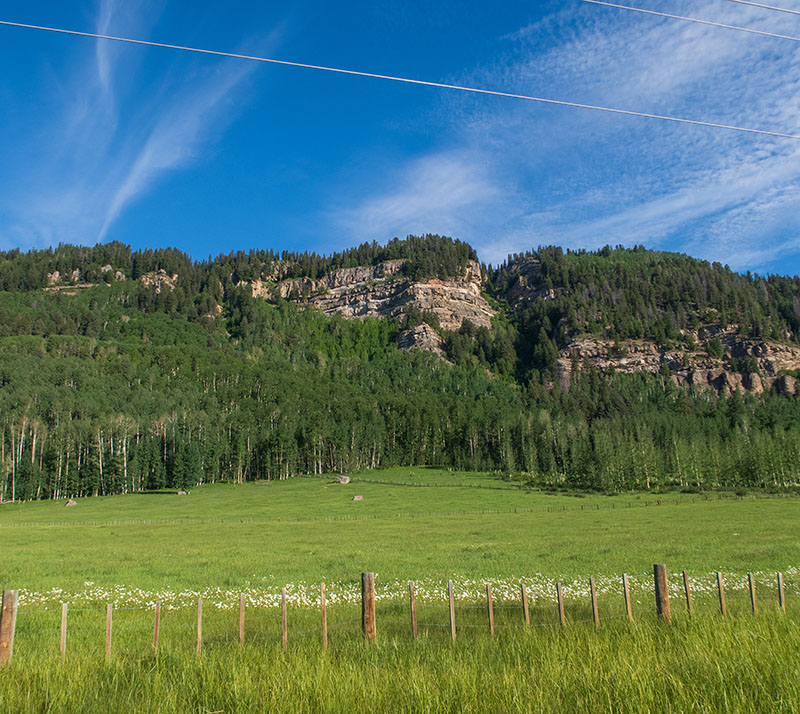Even if you’re ultra-prepared for your Durango home building project, it’s natural to experience a dose of jitters before the shovel hits the dirt. What if you make critical choices you’ll regret down the road?
We’ll let you in on a secret: when you locate and design the house to take full advantage of its site, other decisions have a way of falling into place. Whether you’re planning a dramatic mountain home on Southwest Colorado acreage or building a house in an existing neighborhood, embracing the advantages and challenges of your property can make all the difference in creating the home of your dreams.
A Relationship with the Land
Once you’ve found a gorgeous parcel of land, next step is to begin to envision how your home will harmonize with its setting and provide the inviting indoor spaces you’re looking for. You may know the basics—like it’s not usually advisable to build squarely on top of a hill—but beyond those, how do you plan the right fit?
Start by evaluating these elements:
Topography
In the best-case scenario, your property is gently sloping without expanses of exposed boulders. You’ll save money in excavating and grading, and careful design may allow you to include that walk-out or daylight basement you’ve been hoping for.
If your land is steep, you may need to consult an engineer about where and how to build, whether retaining walls should be part of your plan, and where to locate the driveway, well and water lines, and the septic tank. If the terrain is flat, pay close attention to natural water flows so seasonal thunderstorms don’t cause water to accumulate where you don’t want it.
When you’re working with a site that doesn’t yet have utilities, you’ll need to find out how to get power to the home you want to build and how this key pre-build consideration may affect design. While you’re at it, keep an eye on the future. Maybe the city plans to bring sewage lines to your area in the years to come—will there be a route from the main road that makes sense.


Whether your property offers lovely Rocky Mountain vistas or the chance for picture windows to frame lovely nearby scenery, you’ll want to take every opportunity to invite the outdoors in. The best way to do this is to choose a Southwest Colorado builder and architect who are experienced with local terrain and enjoy working closely together on projects like yours.
Sun
Designing your home to welcome rather than battle the Four Corners sun is key to your comfort and to minimizing wear and tear on surfaces. To warm your home in winter, it’s often a good idea to situate the house so that window walls face close to due south. If you include generous roof overhangs, low-hanging winter sun will come inside while rays from the hot summer sun will be screened out. Pay attention to trees, slopes, and other features of the property that may also impact sun patterns.
Wind
Colorado can be notorious for windy weather, as high- and low-pressure systems often converge in the area. Gaining familiarity with local conditions—through weather experts and neighbors—can make a big difference in ensuring the utmost in livability for your home. When you know the prevailing wind direction, you can design decks, patios, and doors to be shielded by hills or rocky outcroppings. Strategic landscaping can also help buffer unprotected zones.
Water
If you’re lucky enough to have a water feature on your land such as a pond or a creek, you may want to build nearby to enjoy the sounds and sights. Just be careful you don’t situate the home too close. When you walk your property to observe natural water flows, look for signs of flooding too. You may see obvious high-water marks, or you might have to look above ground in shrubs to spot clumps of debris.
At Home in the ‘Hood
When your property is located in a suburban neighborhood or an existing development, familiarizing yourself with city and county regulations and/or homeowner’s association CCNRs (covenants, conditions, and restrictions) is essential. These will cover setbacks from property lines and define what professionals term the “buildable envelope” for your land. They will also come into play if you need a well and septic system.
Beyond these technical details, there are other aspects of building in a neighborhood to think through. For instance, since sound travels more readily through windows than through walls, you may want your largest windows located away from street noise. As you envision your windows, it pays to plan for privacy today and tomorrow. If you include large windows based on landscaping next door, what will happen if owners remove trees or shrubs?
A quick word about the architectural style you have in mind. Even if there are no restrictions on the ultimate look of your home, it’s often best to consider designs that blend in well with surrounding houses. You may not mind having a modern industrial home on a street of Victorian houses, but your neighbors—and future buyers—may not feel the same way.
Words of Wisdom
Experts will tell you to visit your property often, with tools in hand such as cameras, measuring tapes, marking flags, and a notebook. Go at varying times of day and even in different seasons if you can. Take copies of your property survey (or “plat”) so you can try sketches or cutouts of your dream home. Make notes regarding views, weather patterns, and more.
Speaking of experts, consider using the Home Builders Association of Southwest Colorado as a resource. We can refer you to architects, engineers, excavators, and builders who are highly experienced in new home construction in Durango. And let us know how your project turns out!




